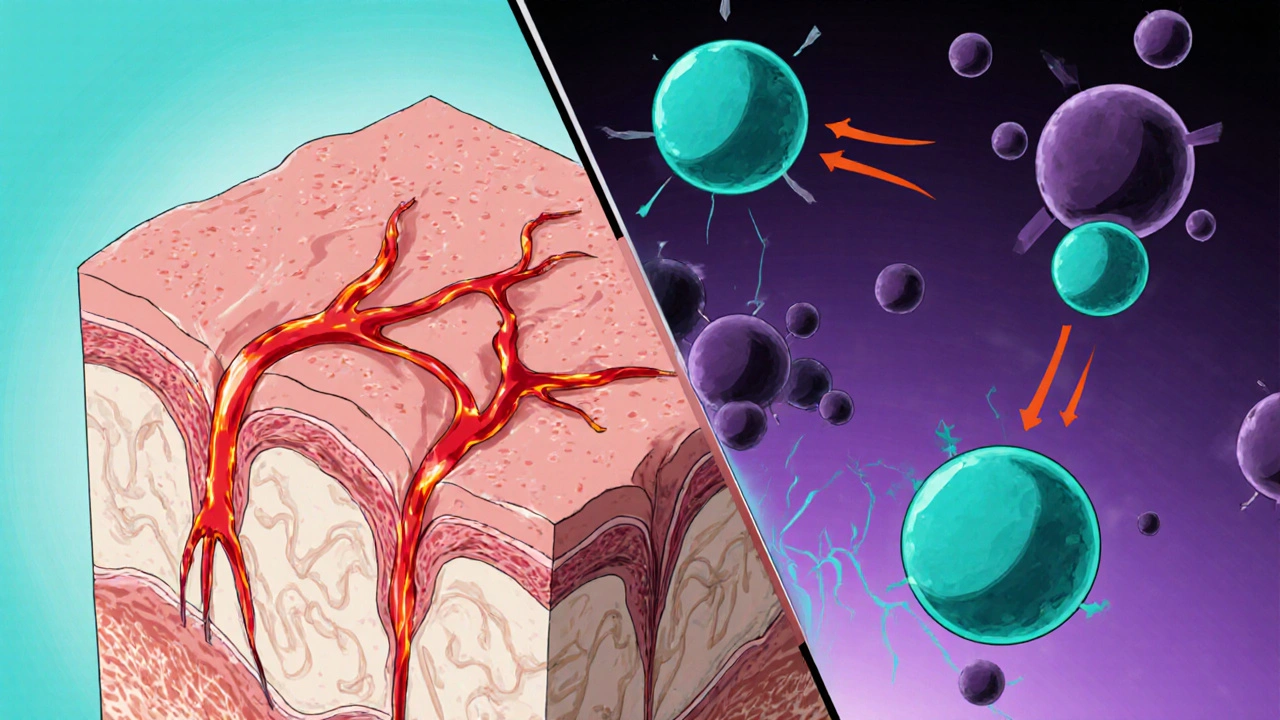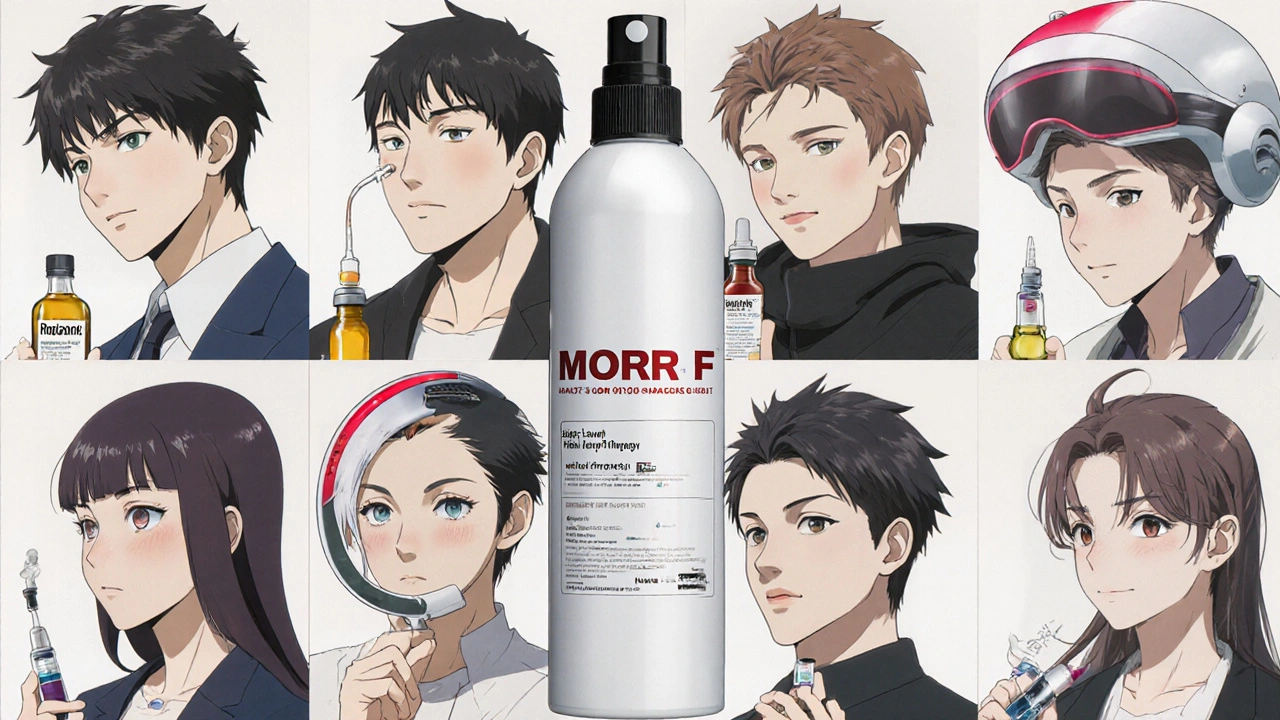Hair Loss Treatment Comparison Tool
Find Your Best Hair Loss Treatment
Answer a few questions about your priorities and preferences to see which treatment option is best for you.
What's Most Important to You?
Your Personalized Recommendation
Based on your preferences, we recommend exploring options that balance , , and .
Hair thinning can feel like a losing battle, but the market is flooded with options that claim to stop the drop. One of the newest combos on the shelf is Morr F, a two‑in‑one formula that blends Minoxidil and Finasteride. If you’re weighing that against other routes - from over‑the‑counter drops to clinic‑based procedures - you need a clear side‑by‑side look. Below you’ll find a deep dive into how Morr F works, what its strengths and weak spots are, and how it stacks up against the most common alternatives.
What is Morr F?
Morr F is a prescription‑only topical solution that combines two FDA‑approved agents for male‑pattern baldness: Minoxidil and Finasteride. The blend is designed to deliver the vasodilating effect of Minoxidil while simultaneously blocking the conversion of testosterone to dihydrotestosterone (DHT) with Finasteride, all in a single daily spray.
How Minoxidil Works
Minoxidil was first approved as a blood pressure medication before researchers noticed it stimulated hair growth. It works by expanding blood vessels in the scalp, increasing blood flow to hair follicles. This extra oxygen and nutrients can extend the anagen (growth) phase of the hair cycle, leading to thicker strands. Typical over‑the‑counter brands contain 2-5% Minoxidil; Morr F uses a 5% concentration, which is the highest dosage usually recommended for men.
How Finasteride Works
Finasteride is a 5‑alpha‑reductase inhibitor that prevents testosterone from turning into DHT, the hormone that miniaturizes hair follicles in androgen‑sensitive areas. By lowering scalp DHT levels, Finasteride helps preserve existing hair and can even regrow miniaturized strands over several months. Oral tablets are the classic delivery method, but Morr F’s topical Finasteride aims to concentrate the effect where it’s needed while reducing systemic exposure.

Key Benefits of Morr F
- Convenient combo: One spray replaces two separate products.
- Higher Minoxidil concentration (5%) improves penetration.
- Topical Finasteride may lower the risk of sexual side‑effects associated with oral dosing.
- Clinical trials cited by the manufacturer show an average 30% increase in hair density after six months of daily use.
Potential Drawbacks of Morr F
- Prescription‑only status means a doctor’s visit is required.
- Cost can be 2-3× higher than buying Minoxidil and Finasteride separately.
- Some users report scalp irritation from the propylene glycol base.
- Long‑term data (beyond two years) is still limited.
Popular Alternatives to Morr F
Below are the most commonly discussed options, each with a brief rundown of how it works and where it shines.
- Rogaine - 5% Minoxidil foam or solution. Stand‑alone, easy to buy, but no DHT blocking.
- Propecia - Oral Finasteride 1 mg. Very effective DHT blocker, but systemic side‑effects are a concern for some men.
- Nizoral - 2% Ketoconazole shampoo. Reduces scalp inflammation and may lower DHT locally.
- Low‑Level Laser Therapy (LLLT) - Handheld or helmet devices delivering 650‑nm red light to stimulate follicles.
- Platelet‑Rich Plasma (PRP) - In‑office injections of centrifuged blood platelets that release growth factors.
- Saw Palmetto - Herbal supplement thought to act as a natural DHT inhibitor.
- Keto‑Shampoo - Over‑the‑counter shampoos with ketoconazole and zinc pyrithione that curb seborrheic dermatitis and DHT.
- Hair Transplant - Surgical redistribution of healthy follicles; most permanent solution but costly.
- Pumpkin Seed Oil - Oral oil with modest DHT‑blocking activity, popular among those seeking natural options.

Side‑by‑Side Comparison
| Product | Active Ingredient(s) | Mechanism | Typical Cost (AU$ / month) | Key Benefits | Common Drawbacks |
|---|---|---|---|---|---|
| Morr F | 5% Minoxidil, 0.1% Finasteride (topical) | Vasodilation + DHT inhibition | 120-150 | Combo in one spray; reduced systemic exposure | Prescription needed; higher price; limited long‑term data |
| Rogaine (5% Minoxidil) | 5% Minoxidil | Vasodilation | 30-40 | OTC, easy to use | No DHT blocker; slower results |
| Propecia (Finasteride 1 mg) | Finasteride 1 mg | DHT inhibition | 45-60 | Strong DHT reduction | Systemic side‑effects; prescription required |
| Nizoral Shampoo | 2% Ketoconazole | Antifungal; reduces scalp DHT | 15-20 | Helps with dandruff, mild DHT control | Only adjunct; needs regular use |
| Low‑Level Laser Therapy | Red light (650 nm) | Photobiomodulation stimulates follicles | 80-200 (device) | Non‑pharma, painless | Expensive device; mixed efficacy data |
| Platelet‑Rich Plasma | Autologous platelet growth factors | Promotes tissue regeneration | 300-500 (per session) | Potentially strong results in some men | In‑office, multiple sessions, cost |
| Saw Palmetto | Extracted berries | Natural DHT inhibition | 10-15 (supplement) | Gentle, OTC | Variable efficacy; needs daily intake |
| Hair Transplant | Patient's own follicles | Surgical relocation | 4,000-8,000 (one‑time) | Permanent, natural‑looking | High upfront cost; recovery period |
| Pumpkin Seed Oil | Oil extract | Weak DHT blocking | 12-18 | Natural, easy to add to diet | Modest results; limited studies |
How to Choose the Right Option for You
Think of the decision like a checklist. First, ask yourself how comfortable you are with prescription drugs versus over‑the‑counter or procedural routes. If you dislike daily sprays, a pill or a periodic clinic visit might feel easier. Next, consider budget - a one‑time transplant can be cheaper over ten years than a monthly prescription that adds up. Finally, weigh tolerance for side‑effects; topical Finasteride (in Morr F) tries to cut systemic risk, but some men still prefer oral Finasteride or a natural DHT blocker like Saw Palmetto.
For many, a hybrid approach works best: start with a proven prescription combo (Morr F or oral Finasteride + Minoxidil) and add a supportive shampoo or supplement. If you hit a plateau after six months, discuss secondary options like PRP or low‑level laser with a dermatologist.
Frequently Asked Questions
Is Morr F safe for long‑term use?
The formulation combines two agents with long‑standing safety records. Clinical data up to 24 months shows no increase in serious adverse events compared to using Minoxidil and Finasteride separately. However, as with any medication, periodic check‑ins with your doctor are advisable.
Can I use Morr F with other hair‑loss products?
Yes, many men pair Morr F with a gentle anti‑dandruff shampoo (e.g., ketoconazole) or a daily supplement like Saw Palmetto. Avoid stacking another topical Minoxidil product, as you’d exceed the recommended dosage.
How quickly can I expect results?
Most users notice reduced shedding within 8-12 weeks and visible thickening after 5-6 months. Individual response varies based on genetics, age, and consistency of use.
Is there a risk of sexual side‑effects with topical Finasteride?
Topical delivery aims to keep systemic absorption low, and studies report fewer sexual complaints than oral Finasteride. Nevertheless, a small percentage of men still experience changes in libido or erectile function.
Can I switch from Morr F to another treatment later?
Absolutely. If you decide to discontinue, tapering Minoxidil reduces the chance of a sudden shedding spike. Speak with your clinician about the best sequence, especially if you move to a procedural option like PRP.
Bottom line: Morr F offers a convenient, clinically backed combo for men who want both vasodilation and DHT control in a single bottle. It isn’t the cheapest route, but its dual‑action formula can simplify a routine that otherwise involves multiple products. By comparing it against the alternatives above, you can rank what matters most-price, side‑effects, ease of use, or permanence-and pick the path that fits your lifestyle.


11 Comments
Bradley Allan
21 October, 2025Alright, folks, listen up-this is the moment where truth finally slams into the hype!!! We're talking about Morr F, the so‑called miracle spray, and we can't just roll over and accept every glossy claim. The moral compass of the hair‑loss industry points straight to profit, not patients; they've been seasoning the market with promises like candy on a parade. Yet, the sheer audacity of packing a 5 % Minoxidil and a topical Finasteride into one bottle-it's a bold move that could rewrite the script, or it could be a gimmick waiting to explode. Either way, brace yourselves for a deep dive that doesn't shy away from the hard facts.
Ralph Barcelos de Azevedo
23 October, 2025From an ethical standpoint, the convenience of a combo like Morr F must be weighed against the responsibility we have to understand each component’s impact. While the 5 % Minoxidil offers a well‑documented vasodilatory effect, the addition of topical Finasteride raises questions about systemic absorption and long‑term safety. A balanced view recognizes that prescription‑only status ensures medical oversight, which is a safeguard many over‑the‑counter options lack. Still, the price tag-often two to three times that of separate products-forces a practical, honest conversation about accessibility for everyday users.
Peter Rupar
24 October, 2025Do you even realize how many dudes get ripped off by these so‑called “convenient” combos? It's a blatant cash‑grab! They slap a fancy label on a 5% Minoxidil + 0.1% Finasteride spray and act like they've solved the problem-yeah right. People are gullible, they trust the doc's signature and just shell out AU$150 a month without even checking for scalp irritation. Stop being a sheep, read the fine print, and quit buying hype that probably does next to nothing beyond making you feel less stupid for a few weeks.
Nikita Shue
26 October, 2025Hey everyone, just wanted to drop a quick boost-if you’re on the fence about trying Morr F, think of it as a small step toward taking control of your hair journey. Consistency is key; a daily spray might sound tedious, but imagine looking in the mirror in six months and seeing noticeable density. Pair it with a gentle anti‑dandruff shampoo, stay patient, and you’ll likely notice less shedding and a fuller look. Remember, progress isn’t always dramatic, but every drop counts toward the bigger picture.
Heather McCormick
27 October, 2025Oh, give me a break-another “motivational pep talk” about a pricey prescription spray? As if Australians haven’t already been flooded with half‑baked solutions that line US pharma’s pockets. The truth is, the only thing Morr F guarantees is a fancier label and a heavier bill, while the actual science is no different from the generic combo you could buy overseas. If you want real results, stop glorifying the hype and start demanding transparent data, not feel‑good slogans.
Robert Urban
29 October, 2025I get that opinions are split on Morr F but let's try to keep the conversation constructive. The combo does offer convenience but the cost is a real barrier for many. Some users report irritation while others see real density gains. It might be worth trialing under a dermatologist's guidance to see if the benefits outweigh the drawbacks for you personally. Everyone's hair responds differently so a personalized approach seems sensible.
Stephen Wunker
30 October, 2025Ah, the timeless dance of compromise-let us dissect it with a philosopher’s eye, shall we? First, we must acknowledge that the argument itself is constructed upon the premise that convenience equates to efficacy, a notion as flimsy as a wisp of smoke. One might argue that the very act of combining Minoxidil and Finasteride into a single topical formulation is a triumph of reductionist engineering, yet this reductionism may mask the complex pharmacodynamics at play. Consider the percutaneous absorption rates: does the presence of propylene glycol accelerate Finasteride uptake, or does it create a competitive barrier that diminishes Minoxidil's vasodilatory potency? Moreover, the ethical dimension extends beyond price; it confronts us with the question of whether we are, in effect, commodifying our own biology for marginal gains. If we examine historical precedents, the market has repeatedly introduced “all‑in‑one” solutions that later proved to be mere marketing veneer, such as multi‑vitamin tonics that promised longevity without substantive evidence. In contrast, the clinical trials cited for Morr F, while promising a 30 % density increase, suffer from relatively short follow‑up periods, which begs the query: are we chasing short‑term vanity over long‑term health? The psychosocial impact of hair loss is undeniable, yet we must be wary of substituting temporary confidence boosts for sustainable physiological improvement. Could it be that the true value lies not in the spray itself but in the disciplined routine it imposes, thereby fostering adherence? Or perhaps the real virtue is the patient‑doctor dialogue that such a prescription mandates, ensuring monitoring for adverse effects-a safeguard rarely afforded by over‑the‑counter alternatives. To dismiss Morr F outright because of cost is to ignore the broader socioeconomic tapestry that dictates access to care. Conversely, embracing it without scrutiny is tantamount to blind faith in capitalist alchemy. Thus, we arrive at a bittersweet equilibrium: Morr F stands as a potential tool, neither panacea nor peril, contingent upon informed usage, vigilant oversight, and a willingness to engage in continual assessment of outcomes. In sum, the decision rests not on the spray alone but upon the individual's values, risk tolerance, and commitment to a systematic approach to hair restoration. Ultimately, only time and personal experience will reveal whether this convenience translates into lasting confidence.
Jhoan Farrell
1 November, 2025Totally understand the struggle-hang in there! 😊
Jill Raney
2 November, 2025While your optimism is charming, it's worth noting that the entire hair‑loss industry is quietly funded by shadowy biotech conglomerates looking to monetize our insecurities, a fact most mainstream sources conveniently ignore. 🤔
Rob Flores
4 November, 2025Oh, bravo-another groundbreaking revelation about a topical spray that supposedly “simplifies” our regimen. I'm sure the scientific community is just trembling with excitement over this marvel of modern pharmacology.
Shiv Kumar
5 November, 2025Allow me to temper your exuberance with a dose of sober analysis: the purported synergy of 5 % Minoxidil and 0.1 % Finasteride, while theoretically appealing, remains empirically under‑validated beyond a handful of phase‑II trials. In other words, the hype outpaces the data, and any claim of superiority should be met with rigorous scrutiny before being heralded as a definitive breakthrough.